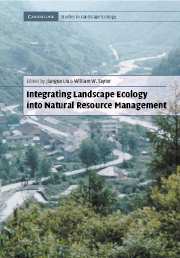Book contents
- Frontmatter
- Contents
- List of contributors
- Foreword
- Preface
- Acknowledgments
- PART I Introduction and concepts
- PART II Landscape structure and multi-scale management
- PART III Landscape function and cross-boundary management
- 7 Assessing the ecological consequences of forest policies in a multi-ownership province in Oregon
- 8 Incorporating the effects of habitat edges into landscape models: Effective area models for cross-boundary management
- 9 Aquatic-terrestrial linkages and implications for landscape management
- PART IV Landscape change and adaptive management
- PART V Landscape integrity and integrated management
- PART VI Syntheses and perspectives
- Index
- Plate Section
9 - Aquatic-terrestrial linkages and implications for landscape management
Published online by Cambridge University Press: 14 January 2010
- Frontmatter
- Contents
- List of contributors
- Foreword
- Preface
- Acknowledgments
- PART I Introduction and concepts
- PART II Landscape structure and multi-scale management
- PART III Landscape function and cross-boundary management
- 7 Assessing the ecological consequences of forest policies in a multi-ownership province in Oregon
- 8 Incorporating the effects of habitat edges into landscape models: Effective area models for cross-boundary management
- 9 Aquatic-terrestrial linkages and implications for landscape management
- PART IV Landscape change and adaptive management
- PART V Landscape integrity and integrated management
- PART VI Syntheses and perspectives
- Index
- Plate Section
Summary
Introduction
Historically, ponds and lakes were viewed as isolated systems, separate from their surrounding landscapes. Although a stream was recognized as a network interweaving the countryside, its border with the surrounding land was often overlooked. The interface between aquatic and terrestrial habitats was viewed as the strongest of boundaries. Indeed, the visible integrity of ponds and lakes was used as the primary justification for early definitions of “ecosystems” as largely self-contained (Odum, 1971). Several decades later, the relationship between aquatic and terrestrial landscape elements is viewed quite differently. The terrestrial habitat is integrally connected to lotic and lentic systems and provides resources that are essential to their health. The aquatic-terrestrial interface itself is recognized as a porous filter that allows a flow of organisms, water, and matter in both directions. This interface is often a special habitat with its own unique flora and fauna that contribute significantly to the functioning of the surrounding landscape.
The management of the linked aquatic–terrestrial landscape incorporates two primary topics in landscape ecology (Forman, 1995). The first topic centers on the flow of organisms across the aquatic–terrestrial boundary and among different aquatic habitat patches throughout the landscape. The second topic addresses the physical flow of water and matter as a key process linking land and water systems. Flowing water transports substances by both aboveground and belowground pathways across the interface and significantly affects the quality and health of the downstream, receiving system. Sustainability and successful management of wildlife, fisheries, and other natural resources are dependent on the integration of these subject areas.
- Type
- Chapter
- Information
- Integrating Landscape Ecology into Natural Resource Management , pp. 241 - 262Publisher: Cambridge University PressPrint publication year: 2002
- 1
- Cited by



